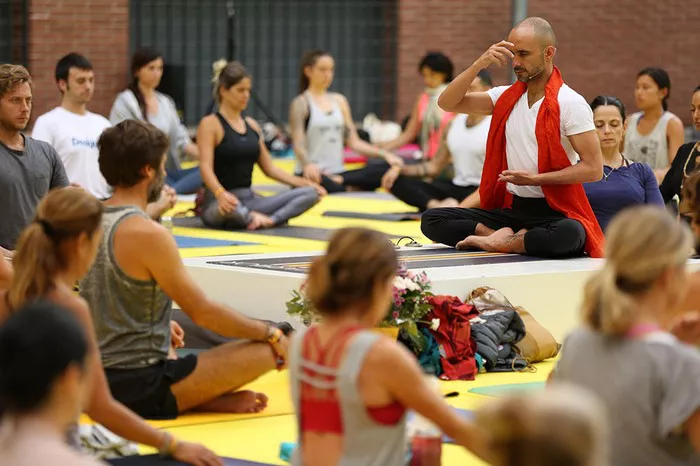Yoga has been practiced for thousands of years, with its roots tracing back to ancient India. It is often seen as a spiritual and physical practice that promotes flexibility, strength, and mindfulness. However, one question that frequently arises is whether yoga can count as cardiovascular exercise, often referred to as “cardio.” The term cardio typically refers to activities that increase the heart rate and improve cardiovascular health, such as running, cycling, or swimming. In this article, we will explore whether yoga can be classified as cardio, how it affects heart health, and how different styles of yoga can vary in their cardiovascular benefits.
What Is Cardio Exercise?
Cardiovascular exercise, or cardio, is any form of exercise that increases the heart rate and enhances the efficiency of the cardiovascular system. The goal of cardio exercise is to improve the heart’s ability to pump blood and the lungs’ ability to deliver oxygen to the body. Examples of typical cardio exercises include brisk walking, running, swimming, cycling, and aerobics. These exercises are generally continuous and elevate the heart rate for a sustained period.
In general, cardio exercises are categorized as either aerobic or anaerobic:
Aerobic exercises: These exercises rely on the continuous use of oxygen to fuel the muscles. They include activities like running, swimming, and dancing.
Anaerobic exercises: These are short bursts of high-intensity exercise that do not rely on oxygen in the same way. Weightlifting, sprinting, and high-intensity interval training (HIIT) are examples of anaerobic exercises.
Now that we know what constitutes cardio, let’s investigate how yoga fits into this equation.
The Impact of Yoga on the Cardiovascular System
Yoga is widely known for its ability to improve flexibility, balance, and mental focus. However, yoga can also provide benefits for heart health, although the way it does so may differ from traditional forms of cardio exercise.
When practicing yoga, certain postures and sequences can elevate the heart rate and improve circulation. In particular, styles that involve more dynamic movement, such as vinyasa, power yoga, and Ashtanga, can offer cardiovascular benefits similar to traditional cardio exercises. This is because these styles often require you to move through poses quickly and continuously, keeping the heart rate elevated over a period of time.
On the other hand, more gentle styles of yoga, such as restorative yoga or Hatha yoga, tend to focus on relaxation and deep breathing rather than cardiovascular exertion. These styles are less likely to significantly increase the heart rate, but they still offer other health benefits such as stress reduction, improved flexibility, and mental clarity.
To better understand how yoga affects the heart and circulatory system, let’s explore the physiological responses that occur during a typical yoga practice.
Physiological Effects of Yoga on the Body
Heart Rate and Circulation
In more dynamic forms of yoga, like Vinyasa or Power Yoga, the flow of movements between poses, combined with controlled breathing, can lead to an increased heart rate. This stimulates the cardiovascular system by promoting better blood flow and oxygen delivery throughout the body. While the heart rate may not rise as high as during intense cardio workouts, there is still a moderate level of cardiovascular benefit.
For instance, in a vigorous Vinyasa flow, the combination of quick transitions between poses like sun salutations and a steady flow of breath can keep the heart rate elevated for a sustained period. This can improve circulation and may enhance heart health in individuals who are unable or prefer not to engage in more intense forms of cardio exercise.
Breathing and Oxygenation
In yoga, emphasis is often placed on deep, diaphragmatic breathing. This encourages the body to use oxygen more efficiently and can increase the intake of oxygen during physical exertion. Deep breathing during yoga has been shown to improve lung capacity and overall respiratory function. It also helps in reducing stress and promoting relaxation, which contributes indirectly to cardiovascular health by lowering blood pressure.
Blood Pressure
Yoga has been found to lower blood pressure in many individuals, especially those who practice regularly. In addition to lowering blood pressure, yoga also encourages mindfulness and relaxation. This can help reduce stress hormones like cortisol, which are known to contribute to higher blood pressure when elevated for extended periods.
Endurance and Strength
While yoga may not push the body in the same way as high-impact cardio exercises, it can still improve overall endurance and muscular strength. Holding poses for extended periods or flowing through sequences can enhance stamina. This strength helps support cardiovascular health, as a stronger body can more efficiently pump blood throughout the system. Additionally, stronger muscles demand less effort from the heart, which can improve heart function over time.
Types of Yoga That Provide Cardiovascular Benefits
Now, let’s examine specific styles of yoga to determine which ones provide the most significant cardiovascular benefits.
1. Vinyasa Yoga
Vinyasa yoga is often called “flow” yoga because it involves linking breath with movement in a continuous flow of poses. The movements are usually quick and dynamic, with the practitioner transitioning from one posture to another with little rest in between. This constant motion and controlled breathing help elevate the heart rate, making Vinyasa a great option for those seeking cardiovascular benefits. Some Vinyasa classes may even include sequences similar to aerobic exercise, where the heart rate stays elevated for extended periods.
The cardiovascular benefits of Vinyasa yoga can be compared to moderate-intensity cardio activities, such as brisk walking or light jogging. It’s an excellent choice for people who enjoy variety in their workout routines and want to incorporate flexibility and mental clarity with cardiovascular conditioning.
2. Ashtanga Yoga
Ashtanga yoga is a more rigorous and structured style of yoga that involves a specific sequence of poses, practiced in a set order. This style is more intense than other forms of yoga due to its fast-paced flow and emphasis on breath synchronization with movement. It involves continuous and rapid transitions between poses, which can elevate the heart rate to levels similar to moderate-intensity cardio exercises.
Because Ashtanga yoga emphasizes consistency and speed, practitioners often experience improved cardiovascular fitness, as well as increased strength, stamina, and flexibility.
3. Power Yoga
Power yoga is an intense form of Vinyasa yoga, designed to build strength and endurance while also providing cardiovascular benefits. It incorporates challenging poses, fast transitions, and breath control, which help maintain an elevated heart rate. Power yoga can be a great workout for those looking to combine the mental clarity and flexibility of yoga with the heart-pumping intensity of traditional cardio exercises.
4. Hot Yoga (Bikram)
Hot yoga, or Bikram yoga, is practiced in a heated room, usually around 105°F (40°C). The heat increases the body’s core temperature, making the muscles more pliable and potentially increasing the intensity of the practice. The combination of heat and vigorous postures can elevate the heart rate significantly, and many people report sweating profusely, which can aid in detoxification.
Though some may find the heat challenging, it can increase cardiovascular output in a similar way to traditional cardio workouts. However, caution should be taken, especially for beginners or those with heart conditions, as the intense heat can put extra stress on the body.
5. Kundalini Yoga
While not as physically demanding as some of the more dynamic styles, Kundalini yoga involves repetitive movements, deep breathing, and chanting, which can have a positive impact on the heart and circulatory system. The focus on breath and energy movement can stimulate the cardiovascular system, but Kundalini yoga is generally more focused on spiritual development and emotional well-being than cardiovascular fitness.
How Yoga Compares to Traditional Cardio Exercises
While yoga can offer some cardiovascular benefits, it is important to understand that it does not always replace traditional forms of cardio exercise. In most cases, high-intensity cardio workouts like running, cycling, or swimming provide more significant cardiovascular improvements due to the higher and more sustained elevation of the heart rate.
However, for individuals who have joint issues, those who prefer a low-impact workout, or those seeking variety, yoga can be a great option to supplement cardio exercise. It can be a complementary form of exercise for those already engaging in traditional cardio workouts, or a suitable substitute for people with specific physical limitations.
Conclusion
So, does yoga count as cardio? The answer depends on the type of yoga you practice. While traditional forms of yoga, like Hatha or restorative yoga, are less likely to provide substantial cardiovascular benefits, more vigorous styles like Vinyasa, Ashtanga, and Power Yoga can elevate the heart rate and improve cardiovascular health. Yoga, particularly when practiced in more dynamic and challenging forms, can offer benefits similar to moderate-intensity cardio exercises by improving heart function, circulation, and endurance.
Ultimately, yoga offers a holistic approach to fitness that combines physical, mental, and emotional well-being. Whether practiced alone or in combination with other forms of exercise, yoga can play a valuable role in improving overall health, including cardiovascular health. However, for those looking for significant cardiovascular conditioning, it is recommended to pair yoga with other traditional cardio exercises for the best results.
In summary, while yoga might not replace running or cycling in terms of sheer cardiovascular intensity, it can still offer important benefits for your heart, lungs, and overall well-being, making it a valuable component of a well-rounded fitness routine.
Related Topics:
























